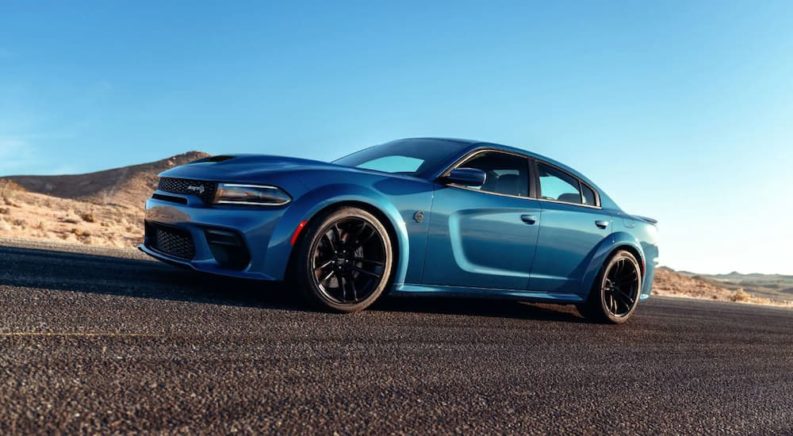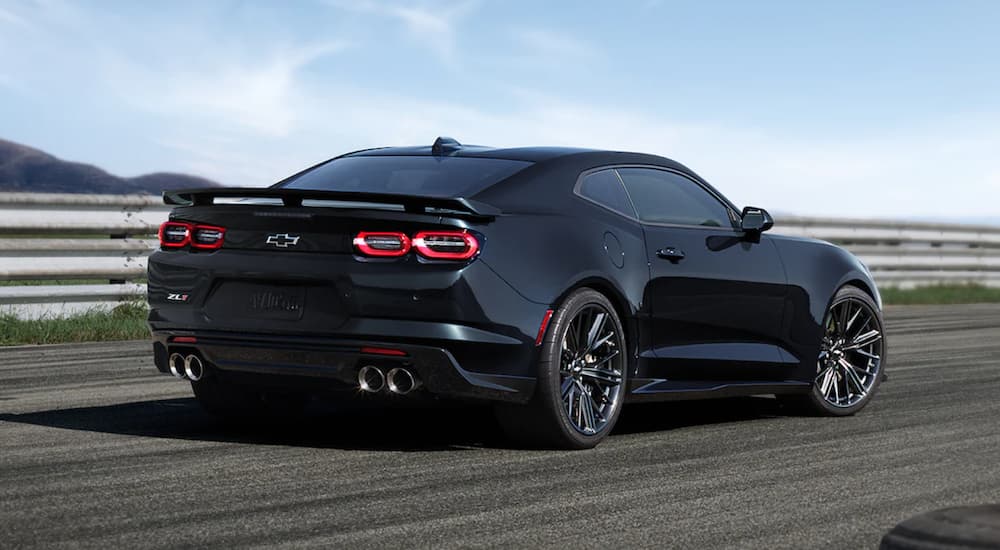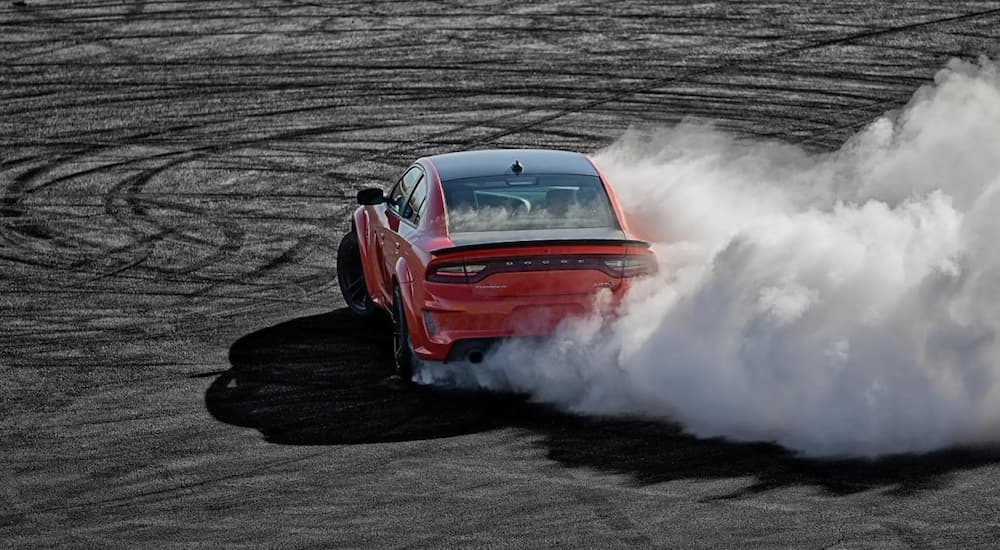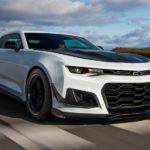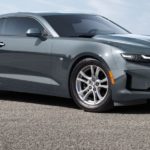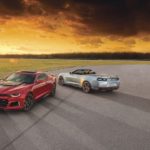Buckle your seatbelts because this is going to be fun. Between the new Hellcat Redeye Widebody and the Wild Cherry red shine, muscle has never looked so good. When two of the most powerful muscle cars flex in their finest, who can resist the allure? If you’re looking to buy a spectacular horsepower-laden machine just because you can, shopping is like going to a sundae buffet with every kind of candy, syrup, and ice cream flavor under the sun. When you dip into the details of the 2021 Dodge Charger vs 2021 Chevy Camaro, you can really pile on the power. For the sake of pure delight, we’ll look at the most drool-worthy trims of each vehicle: the 2021 Charger SRT Hellcat Widebody and the 2021 Camaro ZL1.
Rev Your Engines
Most people will see the eye candy and be magnetically drawn to the style of these powerfully attractive cars, but there can be no containment of thrill when your foot hits the gas to release the roar. Such satisfaction can only come from a throaty growl beneath the hood as a muscle car clears its throat. Each of these fine beasts resembles a creature more like a bison than a wildcat, with brawny capability on a straightaway that really is made for sheer force of will. It plows forth in a thunderous cloud of ripping rubber until it gathers so much steam it will plaster your body to the seat.
The Dodge Hellcat SRT engine stakes its claim as the fastest mass-produced sedan ever. Leave it to Dodge to produce a redonculous four-door sedan with chops to race on a track, including serious performance equipment that we’ll cover later. For now, its jaw-unhinging muscle boggles the mind at a whopping 797 horsepower, with 707 lb-ft of available torque delivered by its supercharged 6.2-liter V8. It can reach a max speed of 202 mph and climbs from zero to 60 at a rapid 3.6 seconds. The beauty of the Charger isn’t necessarily how fast it gets to 60, but rather that getting to 60 is just warming up. It’s all about building momentum.
When you rev up the Camaro, a similarly pleasing rumble emits from its powerhouse, which is no slouch on a drag strip either. Standard fare for the ZL1 is served up with a plate of supercharged V8 bliss that delivers up 650 horsepower with 650 lb-ft of twist. Hit the gas, and the 2021 Camaro leaps from zero to 60 in 3.5 seconds. The Camaro with fewer horses manages to edge itself toward top speeds fractionally faster because of its lighter weight, but make no mistake that the Charger simply has more brawn once it reaches top speeds. Mighty as the Camaro is, it can’t hold a candle to the Charger’s brute force.
Set, and Go!
Behind the wheel of each of these muscle cars is a smorgasbord of engineering and technology that allows every fanatic to properly geek out on all the performance features with dials and screens filled with data. When you open up the 2021 Dodge Charger on the open road, you have mind-boggling equipment to adjust the steering feel, traction, and suspension, including a drive mode that allows custom settings to be dialed in to your own preferences.
The set drive modes for the Hellcat SRT include options for sport and track tuning that lean into performance with stiffer handling, and you can compare your progress with the “performance pages” loaded into the infotainment screen. Using the paddle shifters brings back control to the driver for more response from the available 10-speed transmission, but if you just want a leisurely drive, you can cool it with eco mode to save on fuel. Or, you could just go totally crazy and hit the launch control. Set your RPM and get ready for the Charger fly.
Rear-wheel drive is the only correct way to harness the power of a muscle car, and both the Charger and the Camaro rightfully provide the opportunity for road-burning fun. The Charger, in particular, even has a line lock feature that brakes the front tires while allowing the rear wheels to rotate freely on the pavement. Creating so much heat produces stickier tires that hug the pavement, and Dodge nods to muscle car culture with this move. Add in the adaptive suspension, the air-induction hood with dual heat extractors funneling cool air to the Hellcat engine, the wider body, and the fender flares to house 20-inch tires, and you have a recipe for unleashing surprising balance when you whip roads into shape.
Locking horns with the Charger, the Camaro also provides an available 10-speed transmission with paddle shifters. While the technology of electronic shifting is so good that it doesn’t make much sense to drive stick anymore, the Camaro does offer that option as well. Despite magnetic ride control, however, the Camaro delivers a stiff ride beyond what seems necessary for control. Though Chevy describes this technology as being able to “read the road and change damping in just 10 to 15 milliseconds,” more tuning for a smoother ride quality could improve the experience.
Drive modes for the Camaro allow for similar tuning for steering, suspension, and traction, and despite the stiff quality of the ride, it does handle beautifully and with precision. The ZL1 rides on 20-inch tires like the Charger, and both of these wildly athletic vehicles have exceptional braking power to rein in the speed. Both ponies come with Brembo six-piston front calipers and four-piston rears, and Dodge gives a little extra with high-performance rear brakes that stop it roughly six feet sooner than the Chevy. Behind the wheel, the Charger delivers better balance for sharper handling, while Dodge has taken the time to give buyers the technology and performance options that deliver a true luxury muscle car experience.
Looks Are Everything
There is no denying the attraction to either of these gorgeous vehicles, both of which have shapely exteriors with ferocious front fascia and wind-whipping tail ends. The sculpted hood of the Camaro, lovely as it is, just isn’t quite as satisfying as the air induction hood vents that speak volumes about performance without uttering a sound. Though the convenience of a four-door sports car is fantastic if you have family members you need to ferry around, the Camaro’s coupe body style does lend itself toward traditional muscle looks, and it doesn’t hurt that it can even be had as a convertible. Nothing inspires envy like a convertible with a supercharged engine.
Inside, designers paid close attention to the feel of the track-inspired dials, dash, and vents with modern instrumentation that still hearkens back to its original roots. Dodge upholsters its well-bolstered seats in leather and dresses them with stitched details and badging, while Chevy offers Recaro seats that are similarly stitched and badged. Both cars have heated and ventilated front seats, a heated steering wheel, and driver’s seat memory. Where the Charger takes the upper hand is actually in the back seat, where you find far more space that can actually accommodate real humans – and the back seats are even heated. Unfortunately, Chevy chooses to make the back seats laughably small, to the point where one wonders why they don’t just make the Camaro a two-seater.
Final Lap
It would be remiss not to mention technology since this kind of convenience is an expectation of modern life with smartphones. Apple CarPlay and Android Auto are present in both cars, each of which features its own brand of infotainment that is easy to use. No muscle car worth its salt should be driven without a bass-thumping stereo, but while the Charger comes with a 19-speaker Harman Kardon system, the Camaro only has a seven or nine-speaker Bose sound system.
Conveniences like remote starting, keyless entry, and push-button ignition are all standard fare for both cars, and you can expect all the niceties of modern living with comforts like dual-zone climate control. In all honesty, if someone dropped off either of these vehicles in front of your house, you’d be a happy camper. They both deliver performance that blows the mind and is sure to make you smile, but for the better performance and practicality alone, the 2021 Charger SRT Hellcat Widebody is the better car if you get to choose.

